Stock price in Excel provides a powerful way to track and analyze market data in real time. By integrating live stock information into your spreadsheets, you can monitor trends, compare investments, and make data-driven financial decisions with ease. Whether you’re managing a portfolio, analyzing historical performance, or setting price alerts, using stock price in Excel offers a flexible and efficient solution for investors and financial analysts alike. Leverage this tool to stay ahead in the fast-moving world of stocks and optimize your investment strategies.
- What is the stock price?
- What are the Key Aspects of Stock Price?
- How to Get Daily Stock Prices for the Current Year (YTD) in Excel?
- How to get the Latest USD To CAD Exchange Rate in Excel?
- How to get Weekly Prices For Past 52 Weeks?
1. What is stock price?
An individual stock’s value is determined by the current market price at which it can be bought or sold on the stock market. The price is influenced by both demand and supply, and it can vary depending on factors such as companies, investor sentiment, economic indicators, or geopolitical events. index
2. What are the Key Aspects of Stock Price?
Here are Four Key Aspects of Stock Price.
- Market Decisions: Investors’ willingness to buy shares and their willingness of stock to sell them affect the prices of stocks. When demand is high and supply is limited, prices rise; when demand is low and supply is excessive, prices fall.
- Influencing Factors: News about a company’s financial results, earnings announcements, and product launches can have an impact on its stock prices. The impact of macroeconomic indicators such as interest rates, inflation rate and unemployment rate can be expressed through economic measures. Stock prices are influenced by market sentiment, which includes investors’ perceptions and expectations. Stock prices can be influenced by political stability, international relations, and major world events.
- Price Type: The monetary value of the stock offered by its sellers.
Offer Price: The lowest price that the seller is willing to accept for the stock.
Last traded amount: The final price of the trade.
The price at which the first trade is traded is known as the Open Price.
Closing price refers to closing the most recent trade index.
- Stock Price indicator: By dividing the stock price by total number of shares outstanding, the Market Cap is computed. It offers a rough estimation of the company’s total worth. Price Earnings Ratio (P/E): A valuation ratio that compares the current stock price with the company’s earnings per share (EPS). By dividing the dividend payments by the stock price, investors can achieve a return on their investment through dividends.
3. How to Get Daily Stock Prices For the Current Year (YTD) in Excel?
Step 1: First, enter some dates you want to know about the prices of stocks.
Enter the dates here.
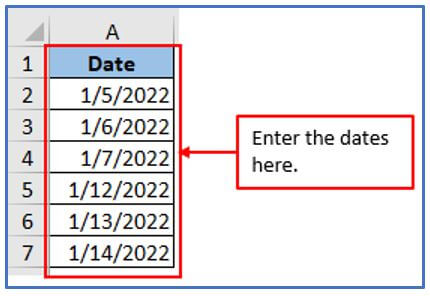
Step 2: Add the column in from B1:B7 to get the stock prices of those dates there.
Add the column here.
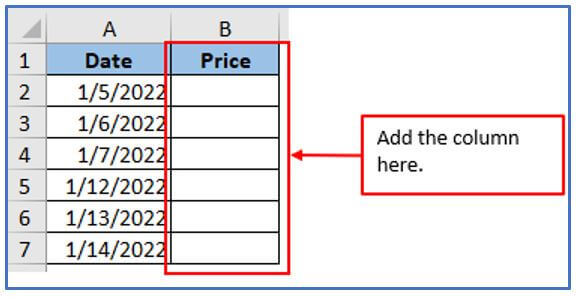
Step 3: Now, use this formula: =STOCKHISTORY(“MSFT”,DATE(YEAR(TODAY()),1,1),TODAY())
ApplY the formula here.

Step 4: Below you can see the stock price of Column A2.
The result is outlined.
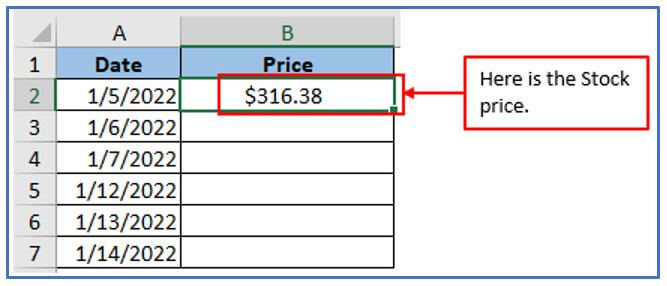
Step 5: Use the same formula from or drag the cursor from B2:B7.
Here are all the stock prices.
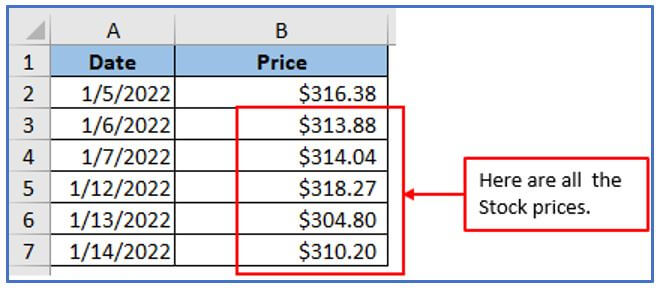
4. How to get the Latest USD To CAD Exchange Rate in Excel?
Step 1: Take a date and enter the date in the Excel as shown below.
The date is entered below.

Step 2: Add the column in from B1:B2 to get the USD To CAD Exchange Rate there.
The column has been added you can see it below.

Step 3: Write the formula. The formula is: =TAKE(SORT(STOCKHISTORY(“USD:CAD”,TODAY()-7,TODAY()),1,-1),2,2)
Used the formula here.

Step 4: Click the enter button then get the latest USD To CAD Exchange Rate
Here is the latest USD-to CAD Exchange Rate below.

5. How to get Weekly Prices For the Past 52 weeks?
Step 1: You have to take some dates you want to know about those date’s stock price and put that data into the Excel sheet.
Place the information here.
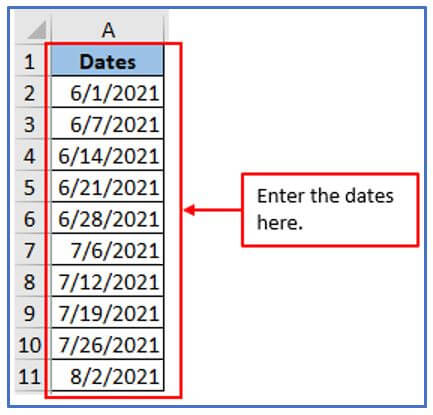
Step 2: Add the column in B1:B11 to get the output there.
The column has been added you can see it below.
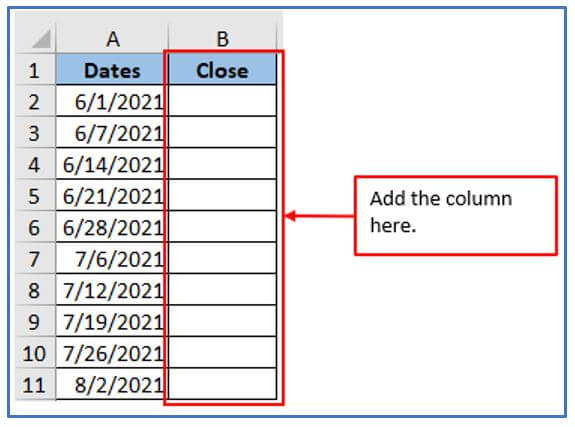
Step 3: Write the formula. The formula will be: =STOCKHISTORY(“MSFT”,TODAY()-(7*51),TODAY(),1)
ApplY the formula here.

Step 4: Click the enter button then get the date.
Here is the result below.
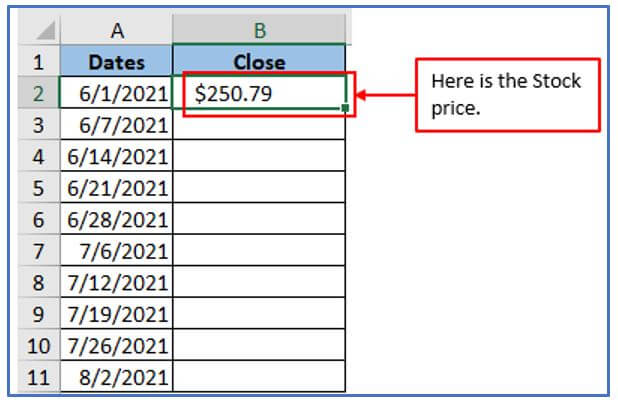
Step 5: Use the same formula or drag down the Excel cursor from B2:B11 and get all the stock prices there.
The results are outlined below.
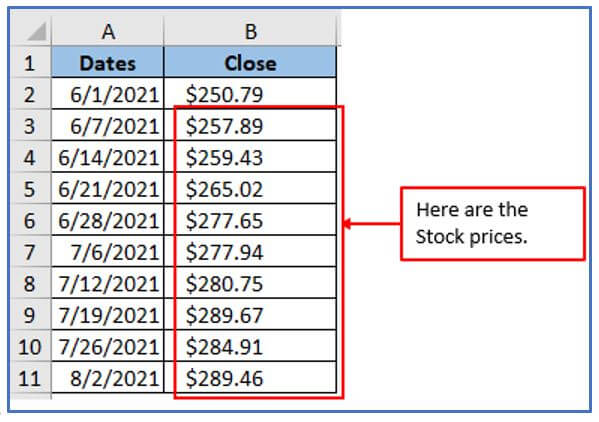
Application of stock price in Excel
- Live Price Tracking: Use Excel to monitor real-time stock prices, keeping track of market fluctuations directly within your spreadsheet.
- Historical Data Analysis: Analyze past stock performance by importing historical stock price data, enabling trend analysis and forecasting.
- Portfolio Management: Manage investment portfolios by integrating stock price data into Excel, tracking individual and total portfolio performance.
- Price Alerts: Set up conditional formatting or alerts based on stock price changes, helping you respond quickly to market movements.
- Investment Comparisons: Compare the performance of multiple stocks by tracking their prices side-by-side in an Excel sheet.
- Financial Modeling: Build financial models and simulations in Excel that incorporate stock price data to project future investment outcomes.
You may be interested:
